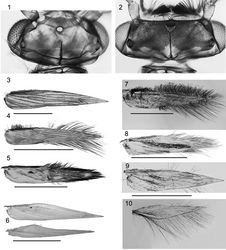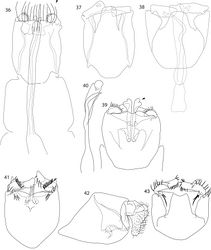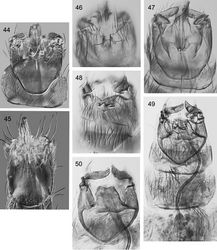Caledonotrichia vexilla
| Notice: | This page is derived from the original publication listed below, whose author(s) should always be credited. Further contributors may edit and improve the content of this page and, consequently, need to be credited as well (see page history). Any assessment of factual correctness requires a careful review of the original article as well as of subsequent contributions.
If you are uncertain whether your planned contribution is correct or not, we suggest that you use the associated discussion page instead of editing the page directly. This page should be cited as follows (rationale):
Citation formats to copy and paste
BibTeX: @article{Wells2013ZooKeys287, RIS/ Endnote: TY - JOUR Wikipedia/ Citizendium: <ref name="Wells2013ZooKeys287">{{Citation See also the citation download page at the journal. |
Ordo: Trichoptera
Familia: Hydroptilidae
Genus: Caledonotrichia
Name
Caledonotrichia vexilla Wells & Johanson & Mary-Sasal, 2013 sp. n. – Wikispecies link – ZooBank link – Pensoft Profile
Diagnosis
Males lack scales on wings but otherwise in features of male genitalia resemble closely those of Caledonotrichia charadra and Caledonotrichia capensis sp. n., having ventral lobes of gonopods triangular but in Caledonotrichia charadra dorsal lobes are somewhat rounded, in Caledonotrichia capensis they are rectangular, while in Caledonotrichia vexilla they are tapered apically; Caledonotrichia capensis has the phallic apparatus short with a sharply angled paramere, while Caledonotrichia vexilla has the phallic apparatus elongate, about length of 3 abdominal segments, and the paramere spine strongly sinuous.
Description, male
Head (Fig. 2) rectangular in dorsal view, length about one-third the width. Antennae with 24–25 flagellomeres; flagellomeres elongate-cylindrical, with length 2.5–3× width. Maxillary palps with basal 2 segments round, segments 3–5 cylindrical, segment 3 relatively stout, slightly longer than segment 5, segment 5 length about 6× width, apical margin truncate.
Forewing (Fig. 7), length 2.2 mm (n=3); wings without scales, forewing densely hairy, with upright bristle-like hairs on veins, and on distal two-thirds costal margin long slender hairs with strongly curved tips.
Genitalia (Figs 41–43, 48–50). Abdominal segment IX in ventral view shield-shaped, distal margin shallowly excavated medially. Tergite X, subquadrate, apical margin concave. Gonopods bilobed, ventral lobe sharply triangular with row of stout setae on apical margin, dorsal lobe subrectangular, tapered slightly towards outer apical angle, mesal process spur-shaped, sclerotised; axillary seta short. Sclerotised rods of subgenital process with a slight irregularity laterally below apex. Phallic apparatus elongate, sinuous, with a stout, sinuous spiny paramere.
Material examined
Holotype male (on slide): New Caledonia: Parc de Rivière Bleu, approx 1 km W Kaori Giant, 19.xii.1998, A. Wells (MNHP).
Paratypes: New Caledonia. 2 males (1 on slide), collected with holotype (ANIC); 6 males, Parc de Rivière Bleu, Rivière Bleue, approx 1 km W Kaori Giant, 19.xii.1998, A. Wells (ANIC); 4 males, Rivière du Cap, approx 8 km NW Naindai, Bourail to Poya road, 22.xii.1998, A. Wells (ANIC).
Other material examined:
New Caledonia 1 pharate male pupa (damaged), 3 cases, Rivière Bleue, bridge forest road, 21.vii.1965, F. Starmühlner (ROM).
Etymology
In reference to the vexatious problem of distinguishing this species from others primarily on the basis of internal features.
Remarks
Males of this small jet black species were collected in bright sunlight as they ran about on an emergent rock in the stream. The three cases collected with the single pharate male pupa from Rivière Bleue, resemble closely those described by Wells (1985: 11) for Caledonotrichia illiesi, having a broad flat margin to the case; however, they lack dorsal vents on the dome seen in that species.
Original Description
- Wells, A; Johanson, K; Mary-Sasal, N; 2013: The New Caledonian genus Caledonotrichia Sykora (Trichoptera, Insecta) reviewed, with descriptions of 6 new species ZooKeys, 287: 59-89. doi
Images
|


